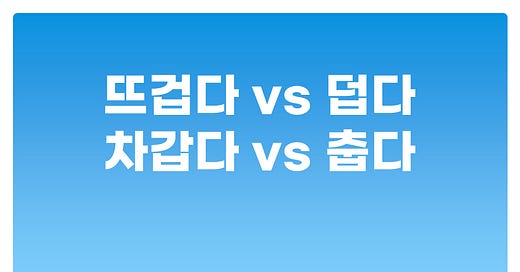Let's study the differences between the pairs of Korean adjectives: "뜨겁다" vs "덥다" and "차갑다" vs "춥다." Although they seem similar, they have distinct usages based on context. I'll explain each word and its proper usage with examples.
뜨겁다 vs 덥다
1. 뜨겁다
Definition: "뜨겁다" is used to describe something that is physically hot to the touch or produces heat.
Usage: This adjective refers to objects, food, or things you can feel directly with your senses.
Example:
"뜨거운 물을 마시면 안 돼요." (You shouldn't drink hot water.)
"커피가 너무 뜨거워요." (The coffee is too hot.)
2. 덥다
Definition: "덥다" refers to the weather or an environment that feels hot.
Usage: It is used to describe how you feel when the air or surroundings are warm, particularly in relation to temperature.
Example:
"오늘 날씨가 너무 더워요." (The weather is too hot today.)
"방이 너무 더워서 창문을 열었어요." (The room was so hot that I opened the window.)
차갑다 vs 춥다
1. 차갑다
Definition: "차갑다" describes something that is physically cold to the touch.
Usage: It’s typically used for objects, drinks, or surfaces that feel cold when touched.
Example:
"차가운 물을 마셨어요." (I drank cold water.)
"손이 너무 차가워요." (My hands are so cold.)
2. 춥다
Definition: "춥다" is used to describe the weather or an environment that feels cold.
Usage: This word expresses how cold the air or surroundings are, particularly the temperature outside.
Example:
"겨울에 날씨가 너무 추워요." (The weather is too cold in the winter.)
"밖이 추우니까 옷을 따뜻하게 입으세요." (Since it’s cold outside, dress warmly.)
Summary:
뜨겁다: Hot to the touch (object, liquid, etc.)
덥다: Hot weather or environment
차갑다: Cold to the touch (object, liquid, etc.)
춥다: Cold weather or environment
By understanding these distinctions, you'll be able to describe both physical sensations and environmental conditions more accurately in Korean!



